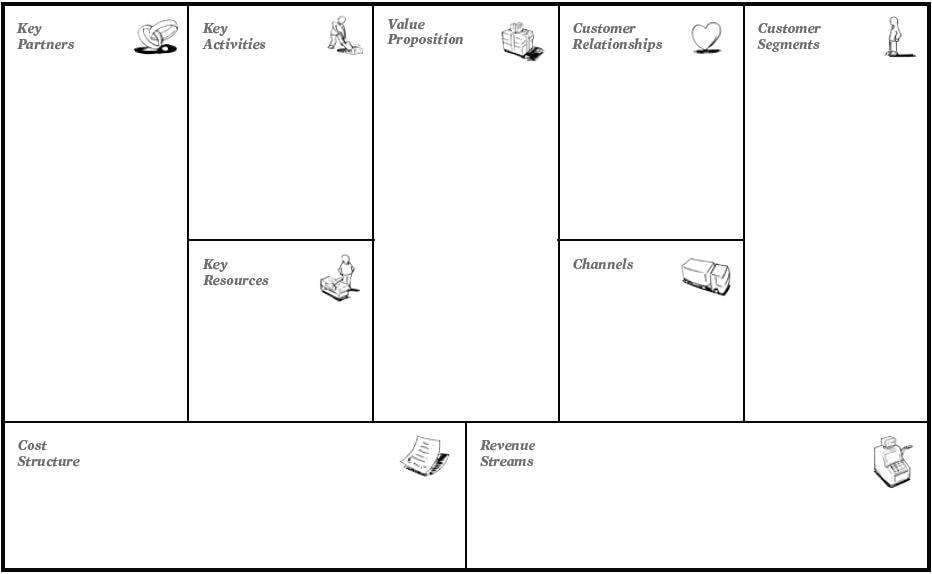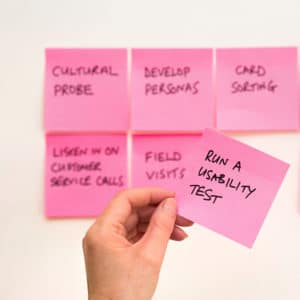How can the Business Model Canvas help you test your idea?
The goal of this article is to help you begin the process of testing your entrepreneurial idea. Concretely, we will be looking at
- what types of questions you should be asking yourself about your potential customers;
- identifying hypotheses that you should verify;
- and defining an order in which to test these hypotheses.
The starting point of this methodology will be the Business Model Canvas. Just in case you have never heard of a BMC before, here a little explanation: the BMC is a powerful tool that you can use to structure your entrepreneurial idea and define exactly how you ultimately plan to make money with your idea. The main advantages of this tool are its ease of use and the speed with which it can help you gain a general overview of your business model in a visual and succinct manner. This is what a blank BMC looks like:

Explaining the intricacies of filling in the BMC is outside the scope of this post; indeed, you will find a plethora of other resources that will help you with this. I personally find this article1 to be very helpful, and of course there is the official book2, called Business Model Generation.
For our purposes in this article, the minimum requirements are that you have completed the three “customer” fields, i.e. “Customer Segments”, “Customer Relationships” and “Channels”.

1. Compile a list of assumptions about your clients
In the first draft of your BMC, you will have jotted down a bunch of assumptions. Your job as an entrepreneur in this early stage of your journey is to verify the validity of these assumptions and thus reduce risk in the launching of your business. Typically, the primary concern of most entrepreneurial projects will be your assumptions about your potential clients and the problems that you are trying to solve for them: this is why we talk about "Client and Problem hypotheses".
As mentioned earlier, you will mainly be looking at the right-hand side of the BMC for inspiration; more specifically, you will want to consult the "Customer Segments" field of your BMC, but also possibly the "Customer Relationships" and "Channels". Make sure that your assumptions about your future clients are detailed enough to answer the five Ws:
- WHO are they?
- WHAT problem do they face?
- WHEN do they face the problem?
- WHERE do they face the problem?
- WHY do they face the problem? In other words, what are the causes of the problem?
If you are having trouble with this step, establishing Client Personas3 for each customer segment might help you.
For example, let's say that I want to open an Indian restaurant in Luxembourg City. The list below details the (fictional) assumptions that I would make about one particular type of customers:
- Who are my customers? Businesspeople working in the city who have recently visited India
- What problem are they facing? A lack of good Indian food
- When do they face the problem? At lunchtime during weekdays
- Where do they face the problem? in Luxembourg City, close to their workplace
- What are the causes of the problem? They do not have the time to travel outside the city for lunch
Your answers to these questions need to be specific enough for you to be able to differentiate your different customer segments when you gather more information about them. Indeed, if you remain too vague at this stage, you will run into the problematic situation of having too many varying profiles grouped together when you interview them. As a result, you will end up having gathered a lot of information, but being unable to gain any insight from it.
2. Transforming these assumptions into verifiable hypotheses
Once you have set up a list of satisfactorily specific and realistic assumptions, you can begin transforming them into verifiable hypotheses (that is, hypotheses that you will be able to validate or refute in the future). The good news is that this process is fairly simple: the assumptions that you compiled in step 1 will feed directly into your hypothesis. Here a template:
I believe that [type of person] (who?) experiences [type of problem] (what? when? where?) because of [limit or constraint] (why?)
So, taking our example from section 1:
I believe that my customers will be [businesspeople working in Luxembourg City who have recently visited India], who experience [a lack of good Indian food at lunchtime during workdays] because [they do not have time to travel to restaurants outside the city].
A couple of pointers when you are working on your client and problem hypotheses:
- As you might expect, you will end up with one hypothesis per customer segment, for whom you have defined a particular problem that you want to solve for him
- It can be that you have defined several problems for certain customer segments, in which case you will want to establish as many hypotheses as you have problems
- Certain projects are strongly reliant on the adhesion of certain suppliers or partners, or even need certain key resources; in these cases, I would strongly suggest that you establish similar hypotheses for them

3. Setting priorities
You have written out your list of hypotheses and thus know exactly what information you need to gather from your clients? Great! Now you need to decide which information you have to gather first. In other words, you need to define an order in which to test your hypotheses.
There are various methods to go about this, but I recommend a simple methodology involving giving two scores from 1-4 to each of your hypotheses based on the following criteria:
a. impact
in other words, if this hypothesis is false, what impact will it have on your project? Score 1 if it would have negligible impact, 4 if it would make your project unviable
b. cost of testing
how difficult is it to test this hypothesis, and how much will this cost you in resources (both time and money)? Score 1 for a costly and prolongated experiment, 4 if it costs you (almost) nothing in time and money
Adding up both scores will allow you to rank your hypotheses from highest to lowest: this gives you an idea of the order in which you should test them. That is, the highest ranked hypothesis is the one you should test first, given that it will have a high impact on your project, but be fairly easy to test, whereas the lowest ranked hypothesis will involve a lot of investment for low returns.
Following this methodology allows you to have a structured approach to your market study, saving you time and resources. Your next step? Coming up with experiments that will allow you to test your hypotheses, and conducting those experiments!
For further reading on the Lean Customer Development methodology, check out this book4!
Download a BMC template or fill it in online here.
Learn more :
1 : Business model canva made easy (article) / 2 : business model generation (book) / 3 : Client Personas / 4 : lean customer development (book)
You liked this content? Share it now!


